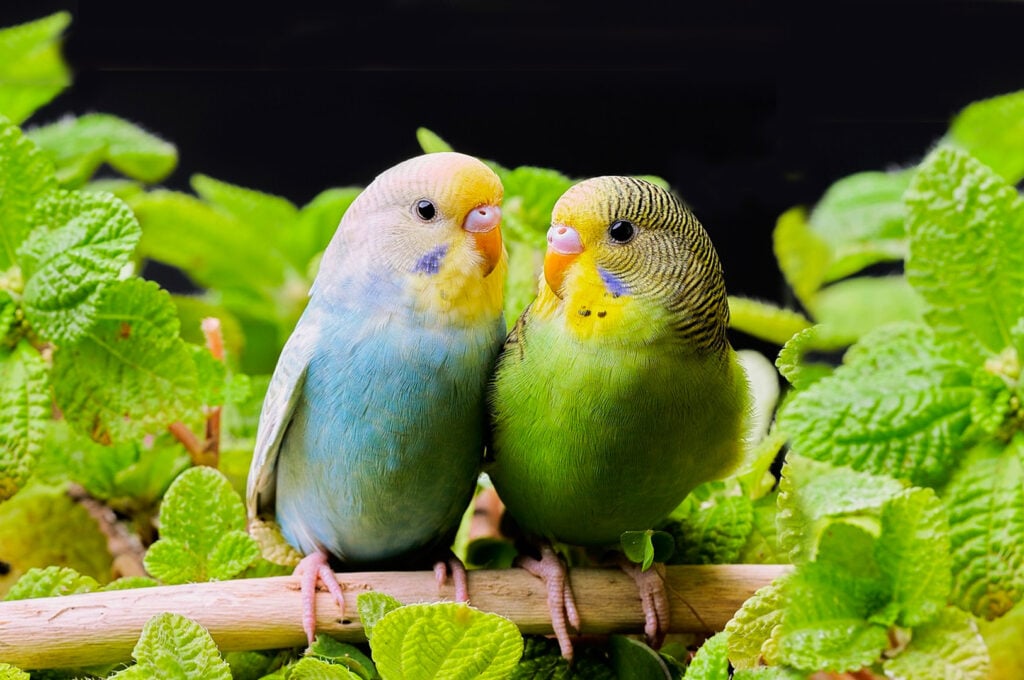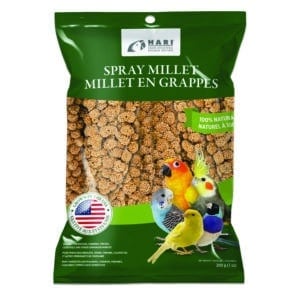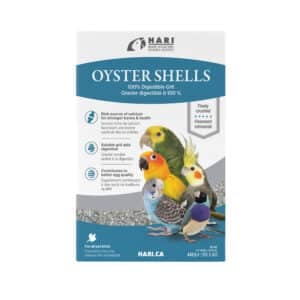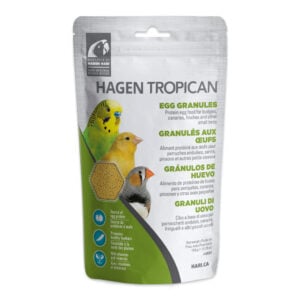Your cart is currently empty!
HARI Official Brand Site
Common Species
Melopsittacus undulatus
Origin/Habitat
Budgies are native to Australia.
Playful and Social Companions
Budgerigars are known for their affectionate and gentle nature, making them easy to train and care for. These intelligent and active birds love to explore, learn, and play. With patience and gentle handling, they can even become finger tame and enjoy being petted once they trust you. Budgerigars can even be taught to imitate human speech and can learn hundreds of different sounds, words, and phrases. In summary, these colourful little birds make excellent companions and can be a lot of fun for the whole family.
Often found in open habitats, primarily in shrublands, open woodland and grasslands, they are normally not far from water, eucalyptus, and plentiful food sources. Because of this, the Gamilaraay Aborigine called this small parrot “Bettcherrygah”, meaning “good food”. Not that the Aborigines ate the birds, but they knew that where flocks of Budgies flourished, there would be plentiful water and food sources for themselves.
Melopsittacus undulatus is the only species in the Melopsittacus genus, but there are different types of Budgies in the pet industry. The most common is the American or Standard Budgie, which is similar in size to wild Budgies, measuring around 18 cm (7 inches) on average. The English Budgie, on the other hand, is much larger, with an average size of 25-31 cm (10-12 inches).
Budgerigars can live for 8-10 years in captivity, with some even living up to 15 years old. With their playful and social nature, these colorful birds make excellent companions for those willing to provide them with the proper care and attention they need.
Physical Description
Small budgies are a diverse group that range from 5 to 11 inches in size and weigh between 23 and 32 grams (0.8 to 1.1 ounces). There are two main types of budgies: American, also known as small standard budgies, and English, which are larger in size.
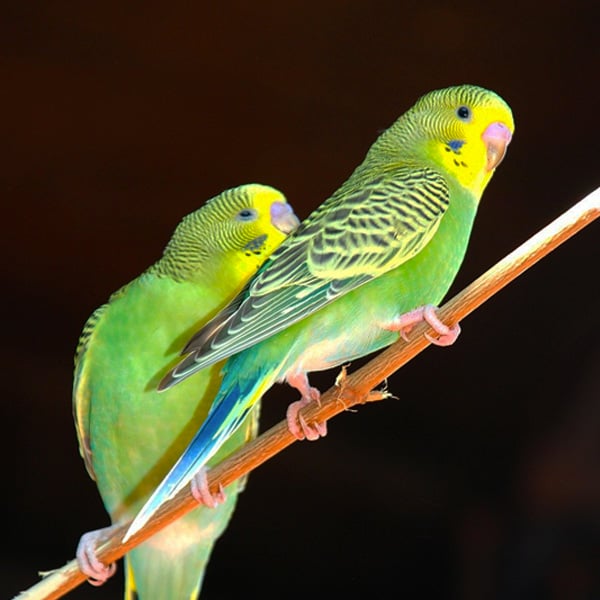
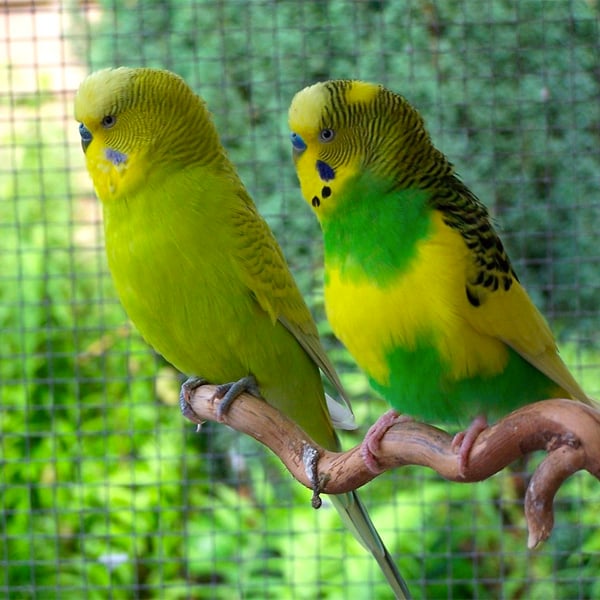
With over 30 primary mutations of budgies in captivity, their colors can range from green, yellow, blue, white, violet, and even albino. Younger birds have black pupils and lines on their foreheads, except for albinos. As budgies mature, the lines on their foreheads recede, and their pupil color lightens. In the wild, budgies have green feathers on their chest, with wings that are a mix of green and black. Their heads are yellow with black lines. Like all parrots, budgerigars have a zygodactyl or yoke-toed foot, consisting of two toes pointing forward and two pointing backward. This foot formation is specifically designed for climbing and grasping.
Health Booklet
Keeping track of bird health by recording their growth, development, behavior and environment in a booklet can help ensure that your companion parrot will be healthy and happy for many years to come.
Sex
Budgies can be sexed once they are mature by looking at the cere (the fleshy part above the beak where the nostrils are). Female budgies have a brownish cere while males have a deep blue cere. Lutino (yellow), albino, and pied budgie males will have a pinkish cere. The cere colour only appears once the bird is about 5 to 6 months old – before this age, it is a pink or purple colour.
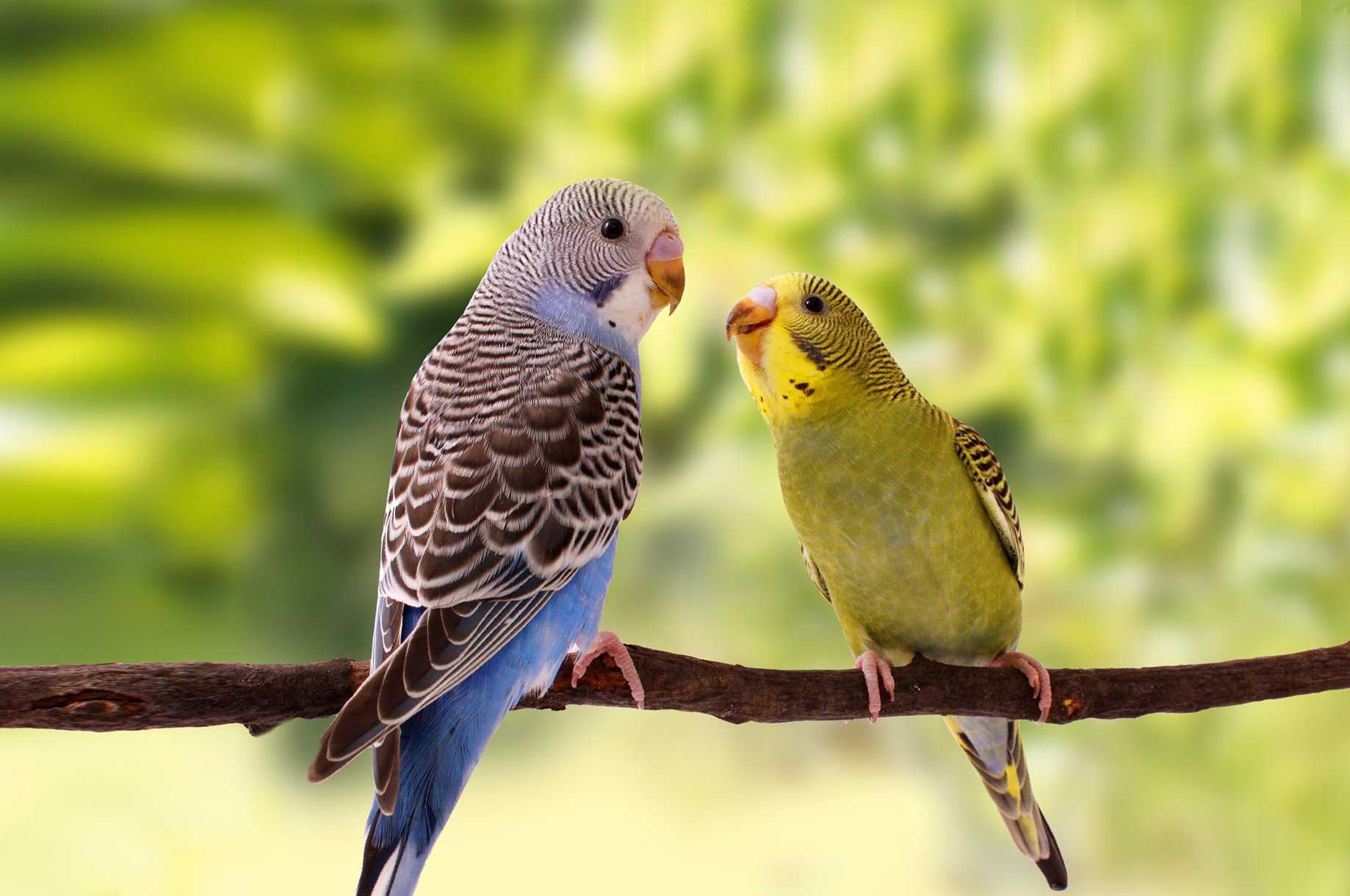
Personality Traits & Behaviors
Budgies are notorious for their amiable and meek temperament. They are highly intelligent, curious, and playful birds with a thirst for adventure and learning. Even if they were not hand-fed as chicks, they make excellent pets when appropriately socialized with humans. With patience and gentle guidance, they can become finger-tame and may even enjoy being petted when they trust you entirely.
Unlike other parrot species, budgies do not usually form a bond with just one person. They are social creatures and thrive on being part of a flock.

Noise Level/Speech/Song
All budgies emit loud contact calls throughout the day. Male budgies will chirp loudly to impress the female. The noises budgies make sound more like chattering and chirping rather than song.
While some parakeets may never learn to mimic human speech, some can be taught anywhere from a few to hundreds of words. In addition to mimicking human speech, parakeets are quite gifted at reproducing other sounds. A sound such as a beeping microwave or a phone ringtone can be picked up quite quickly if repeated often enough.

Intelligence & Learning
Budgies are known for their exceptional intelligence. They can recognize individual people and communicate using a complex language of sounds. Surprisingly, they can learn new behaviors and tricks after just a few attempts. Due to their high intelligence, it’s vital to provide them with engaging toys and foraging opportunities to keep them entertained, active, and mentally stimulated.

Threats/Conservation
Overall budgie populations are on the rise; therefore, there is no major concern for this species. In the wild, the main threat to budgie flocks stems from larger birds of prey.

Relationship with Humans
Budgies, small and quiet birds, can make great pets for families. They are very friendly, but need proper guidance, discipline and training to understand boundaries and expectations. Compared to larger parrot species, budgies are relatively less destructive and can be excellent companions. However, younger children should be supervised when interacting with budgies due to their small size. If you can provide plenty of attention, a single budgie can thrive. Keep in mind that since budgies are flock creatures, they may do better with a companion of their own kind if you are away from home frequently. It’s also important to note that budgies will not breed without a nest box, so two males or two females can get along just as well as a true pair.
For most families, a budgie fits right in with the hustle and bustle of family life.
Care
There is a large selection of cages and starter kits for you to choose from for your pet budgie. Ensure the perfect habitat for your pet budgie by selecting from a wide array of cages and starter kits. To guarantee optimum health and safety, it’s best to invest in the largest cage you can afford. The cage should be at least two and a half times the width of your bird’s wingspan in all dimensions. The cage bars should be spaced close enough that your bird cannot stick their head through, and their tail feathers should not touch the bars when they perch comfortably.
A rectangular cage with horizontal bars provides ample space for your bird to climb and play is the best environment for you parrot. To ensure your budgie’s happiness, place the cage in a well-ventilated room with plenty of natural light, but away from direct sunlight and drafts. Positioning the cage at a height of 3 to 4 feet from the floor is ideal. While your bird will want to be part of the action, it’s best not to place the cage in the middle of it. Positioning the cage against a wall gives your pet a sense of security. For your bird’s safety, never place their cage in the kitchen where heated TeflonTM-coated pans, hot stoves, pots of boiling water, and cooking fumes can harm them. Change the substrate in the cage bottom twice a week, and clean and disinfect the cage and accessories every week with a mild detergent and water solution. Remember to wash the water and treat dishes daily.
Make sure to allow your budgie time outside of its cage every day to socialize and exercise. Budgies are social creatures, and they consider their owners as part of their flock. Spending time with them will make them more comfortable around you. However, ensure that your budgie is supervised while outside the cage to avoid accidents. Keep them away from open doors or windows, toilets with open lids, hot stoves, moving ceiling fans, and large panes of glass. Also, be careful that they do not chew or ingest unsafe items such as treated or painted wood, or unsafe house plants. Finally, avoid keeping your bird in a room where sprays, such as perfume, hair spray, air fresheners, or aerosol sprays, are used frequently.
For the safety of your budgie, we strongly advise against leaving it unattended with other pets, such as dogs, cats, or ferrets.
The basic diet of a budgie consists of a high-quality seed blend. Seed diets are designed to provide the nutrients your budgie needs to stay healthy provided they eat every seed in the mix. VME/Gourmet seed is an excellent basic diet because fat-soluble vitamins, including vitamin A, are added to hulled oat groats (a favourite seed). The challenge with a seed diet is that your budgie will likely pick out their favourite seeds and ignore the rest of the nutritious ingredients. It is advisable to add a vitamin supplement such as PRIME to achieve optimal nutrition. Seed diets are also very high in fat and can lead to health problems such as obesity. A healthier food choice for your budgie is an extruded pellet-based diet like Tropican Egg Granule and Tropimix Egg Food. Most budgies will readily accept Tropican in their diet, however, any change in diet should be done gradually. Check out our feeding recommendations for most passerines and small species. If you are feeding your budgie a pellet-based diet, ask your vet before adding PRIME, as you may be feeding too many vitamins (the pellets are already fortified with vitamins and minerals). Sprinkle PRIME onto fresh leafy greens treats such as sprouts, spinach, romaine lettuce, parsley, dandelions, clover, and chickweed. Give daily during the molting and breeding season, and the rest of the year, two or three times a week.
Supplements such as cuttlebones, HARI Mineral blocks, Clay-Cal®, and HARI Oyster Shells should be provided for your budgie as they are good sources of calcium. Keep charcoal available to help aid in digestion or to help eliminate dietary toxins. An iodine block is also important as budgies can be prone to thyroid problems.
Your budgie will also enjoy fresh enrichments foods such as spinach, kale, romaine lettuce, broccoli, carrot, or apple. These should be washed well and offered to your budgie a few times a week. Always remove any fresh foods within 3 hours to prevent your pet from eating spoiled food.
Offer a variety of healthy treats for your budgie, including millet, honey sticks and egg biscuits. Avoid salty or sugary foods. Never feed your budgie chocolate, alcohol, caffeine beverages or avocado, as even small amounts can be toxic.
Of course, fresh water every day is very important too. Your budgie’s water bowl should be washed and refilled daily.
Budgies typically need 10 to 12 hours of uninterrupted sleep. Many bird owners will cover the bird cage at night to help block out extra light (especially during the summertime). A cover can also keep the cage warmer (for those living in colder climates).
Placing a comfortable perch higher up in the cage will give them a sense of security and keep their feet healthy. If you do not plan on covering the cage or if the bird suffers from night terrors, try using an infrared basking light or a small nightlight in the room.
As your budgie spends all day on its feet, it’s crucial to provide a wide range of perch sizes and types. From wooden perches and ladders to rope and washable plastic perches, there are many options to choose from. Ensure that the perches are appropriately sized for your bird’s feet. You can also add natural branches to the cage to supplement the standard perches. Fresh branches, such as willow, alder, ash, birch, or apple, are excellent for perching and chewing. Simply remove the leaves and swap out the branches every 4-6 weeks.
Budgies are playful and active pets, so it’s essential to give them plenty of opportunities to stay engaged. Ensure that your budgie has access to at least three different types of toys (such as wood for chewing, rope or leather for preening, a bell, a swing, etc.) inside their cage at all times. Consider rotating their toys every couple of weeks to keep them engaged and prevent boredom.
Standard cages for budgies are designed to allow them to exercise outside their cage daily. However, it’s essential to consult your veterinarian about safety when taking them out of their cage. While most budgies have their flight feathers trimmed for taming, they are later left fully grown to allow flight. But keep in mind that several household hazards can pose a threat, so make sure to supervise them always. If you need help with trimming their flight feathers, you can always ask your veterinarian. Additionally, many cages can be easily disassembled to enable the ready removal of the newly clipped budgie for taming and training sessions. Finally, consider removing any swings from the cage until your bird is tamed.
If you want to train your budgie, start with finger training and teach it the step-up command before anything else. With time and practice, these birds can even be taught to talk and perform tricks. However, it’s important to remain patient and consistent. Keep in mind that if you have multiple budgies, they may have a harder time learning human language since they tend to communicate with each other using bird sounds.
Daily bathing is essential to your bird’s health. Bathing moisturizes nasal passages and feet and keeps your birds’ feathers and skin in excellent shape. Budgies will often bathe on their own if you provide them with a bird bath. If your bird is reluctant to bathe on their own, you can use a spray bottle with warm water to gently mist them. Be sure to remove seeds or pellets from the cage before misting as damp food can grow mold and bacteria. Always bathe your bird early in the day and let them dry naturally in a draft-free area.
To maintain a tamer and more friendly pet budgie, it is recommended that you keep their flight feathers trimmed. This process is painless, similar to a regular haircut. Trimming your budgie’s wings will prevent them from gaining too much altitude, but they should still be able to glide safely to the ground. Typically, budgies molt twice a year, so it is important to trim their flight feathers accordingly. Additionally, you will need to regularly inspect and groom their toenails, which are softer than other parrot species and can become overgrown easily. It is highly recommended that a professional bird groomer trim your bird’s nails and wings, as it’s easy to accidentally clip a blood feather if you are unsure of what you’re doing. Keep in mind that wing trimming is not a foolproof method of preventing flight; even just one or two grown-in feathers can give your bird flight ability. As a result, it is essential to never take your bird outside without a secure cage or a properly fitted bird harness.
If you’re a budgie owner, it’s critical to provide a safe environment for your pet. Here are some common household dangers to keep in mind: non-stick surfaces such as TeflonTM, oven cleaner and self-cleaning ovens, cigarette smoke, paint and paint fumes, scented candles, household cleaners, floor polish, hairspray, chlorine bleach, perfume, aerosol sprays, nail polish and nail polish remover fumes, and ingesting harmful or toxic house plants. Everyone in the household should be aware of potentially toxic foods and products for budgies, such as avocados, chocolate, coffee beans, onions, salt, and fruit seeds or pits. Additionally, ceiling fans, cupboards, blinds, open doors and windows can pose a risk as your budgie may fly into them, get trapped, or escape.
Birds often hide signs of illness so take note of any subtle changes in your budgie’s health or behaviour. Budgies should see a veterinarian once a year for a thorough evaluation and preventive health care plan. Some vets treat birds and/or exotic pet species exclusively. There are some clinics that can perform routine bird appointments but will refer you to a certified avian veterinarian for more involved cases. An avian veterinarian is a valuable resource for advice concerning appropriate health care for your budgie.
Availability in the Pet Market
If you’re interested in bringing a pet budgie into your home, there are various ways to do so. Consider visiting an avian specialty shop or pet dealer, or buying from a trustworthy breeder. Another alternative is to search for budgies through online rescue and adoption organizations.
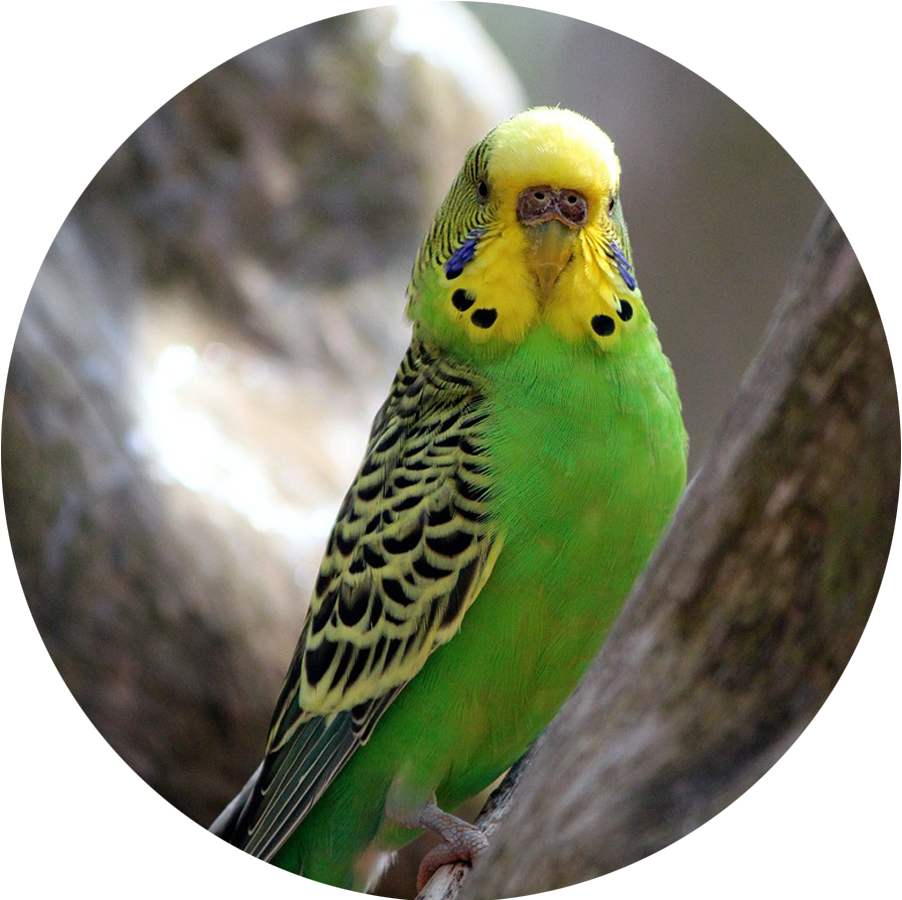
Aviculture
Breeding Habits
Budgies in the wild will only nest when conditions are favorable – typically after a bout of rain. Their clutches usually consist of four to six eggs and the fledglings will leave the nest after about a month. Aviary bred budgies usually mature between 8 months to a year.
Hatchling to Fledgling
Most aviculturists that cater to the pet bird trade prefer to leave the babies with their parents until they are weaned (five to six weeks), but occasionally hand feeding may be necessary. It’s crucial to provide optimal nourishment to both the parent birds and the nestlings for successful breeding. Tropican Egg Granules and Tropimix Egg Food, cuttlebone and HARI Mineral Blocks are excellent options, while Prime Vitamins can also be added to the diet to support breeding pairs.

